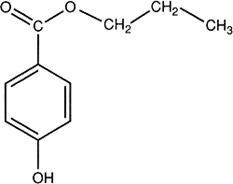Monographs: Pharmaceutical substances: Propyl hydroxybenzoate (Propylis hydroxybenzoas)

C10H12O3
Relative molecular mass. 180.2
Chemical name. Propyl p-hydroxybenzoate; propyl 4-hydroxybenzoate; CAS Reg. No. 94-13-3.
Other name. Propylparaben.
Description. Colourless crystals or a white, crystalline powder; odourless or with a faintly aromatic odour.
Solubility. Very slightly soluble in water; slightly soluble in boiling water; freely soluble in ethanol (~750 g/l) TS and ether R.
Category. Antimicrobial preservative.
Storage. Propyl hydroxybenzoate should be kept in a well-closed container.
Additional information. Propyl hydroxybenzoate is normally used in combination with other hydroxybenzoates.
Requirements
Propyl hydroxybenzoate contains not less than 99.0% and not more than the equivalent of 101.0% of C10H12O3, calculated with reference to the dried substance.
Identity tests
A. Complies with the test under "Melting range".
B. To 0.5 g add 5 mL of sodium hydroxide (~80 g/l) TS and heat in a water-bath for 5 minutes. After cooling, add 6 mL of sulfuric acid (~190 g/l) TS, collect the precipitate on a filter, wash thoroughly with a small amount of water, and dry over silica gel, desiccant, R. Melting temperature, about 214 °C.
Melting range. 96-99 °C.
Sulfated ash. Not more than 1.0 mg/g.
Loss on drying. Dry at 80 °C under reduced pressure (not exceeding 0.6 kPa or 5 mm of mercury) for 2 hours; it loses not more than 5.0 mg/g.
Acidity. Dissolve 0.2 g in 5 mL of ethanol (~750 g/l) TS, add 5 mL of carbon-dioxide-free water R, and titrate with sodium hydroxide (0.1 mol/l) VS, using 0.1 mL of bromocresol green/ethanol TS as indicator; not more than 0.1 mL is required to obtain the midpoint of the indicator (green).
Assay. Place about 80 mg, accurately weighed, in a ground-glass-stoppered flask, add 25 mL of sodium hydroxide (~80 g/l) TS, and boil gently under a reflux condenser for 30 minutes. Allow to cool, add 25 mL of potassium bromate (0.0333 mol/l) VS, 5 mL of potassium bromide (125 g/l) TS, and 40 mL of glacial acetic acid R. Cool in ice-water and add 10 mL of hydrochloric acid (~420 g/l) TS. Stopper the flask immediately and allow to stand for 15 minutes. Add 30 mL of potassium iodide (80 g/l) TS, close the flask and mix. Titrate with sodium thiosulfate (0.1 mol/l) VS, using 2 mL of starch TS as indicator, added towards the end of the titration. Repeat the procedure without the Propyl hydroxybenzoate being examined and make any necessary corrections.
One volume of sodium thiosulfate (0.1 mol/l) VS corresponds to two volumes of potassium bromate (0.0333 mol/l) VS. Each mL of potassium bromate (0.0333 mol/l) VS is equivalent to 6.007 mg of C10H12O3.